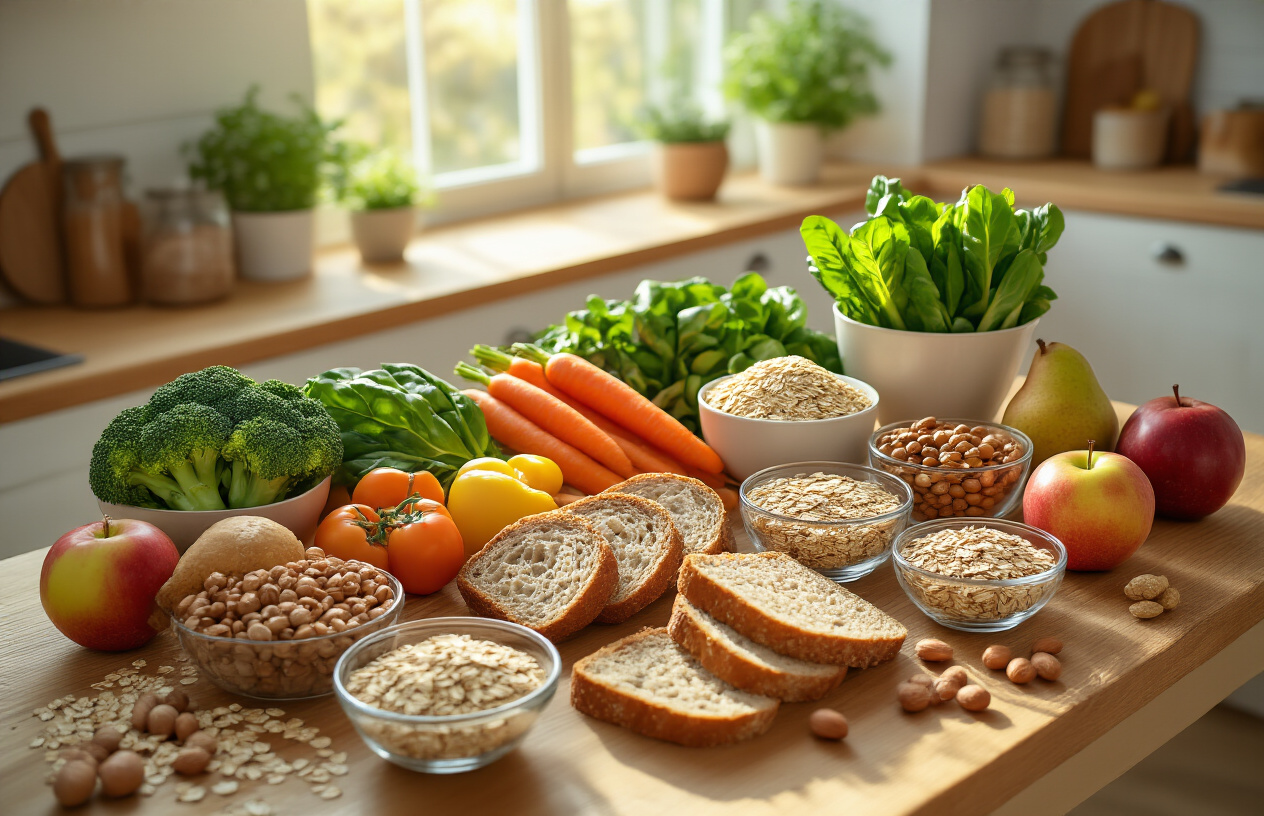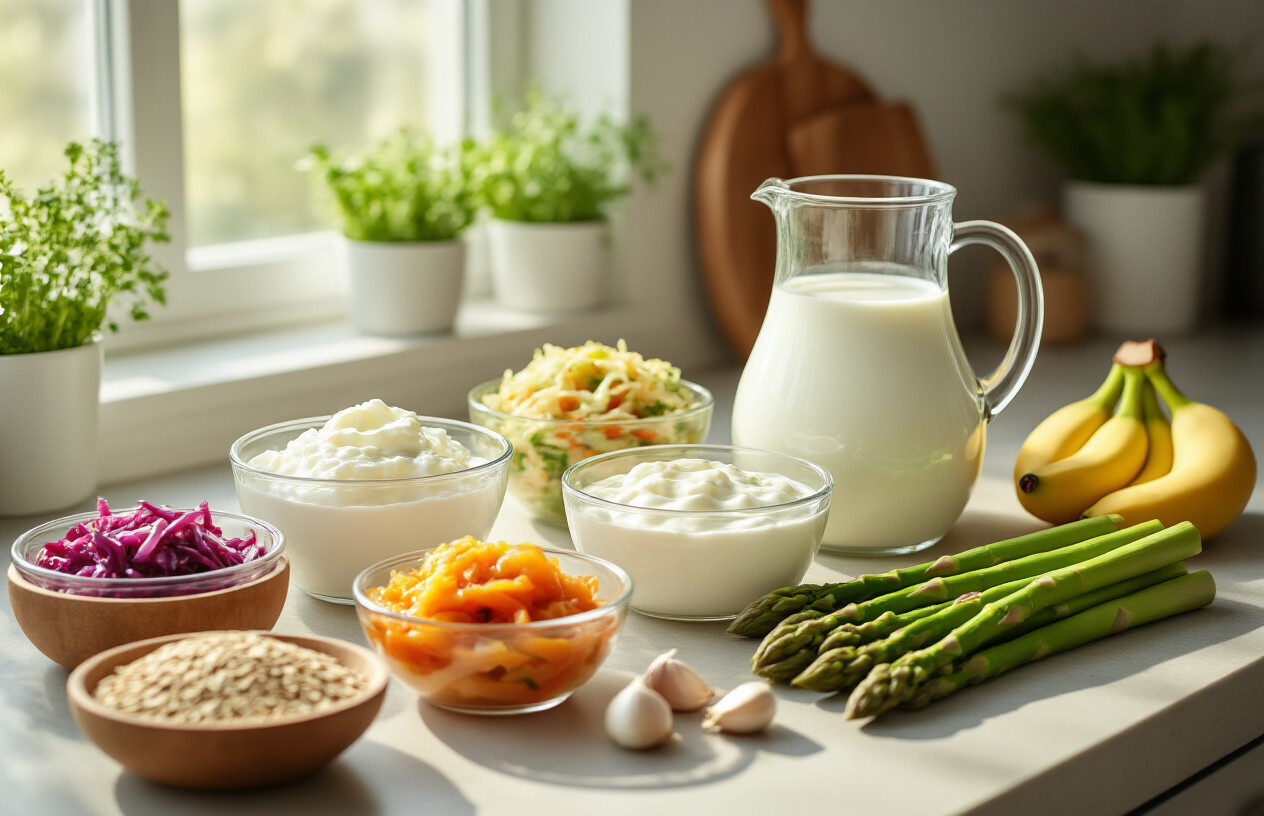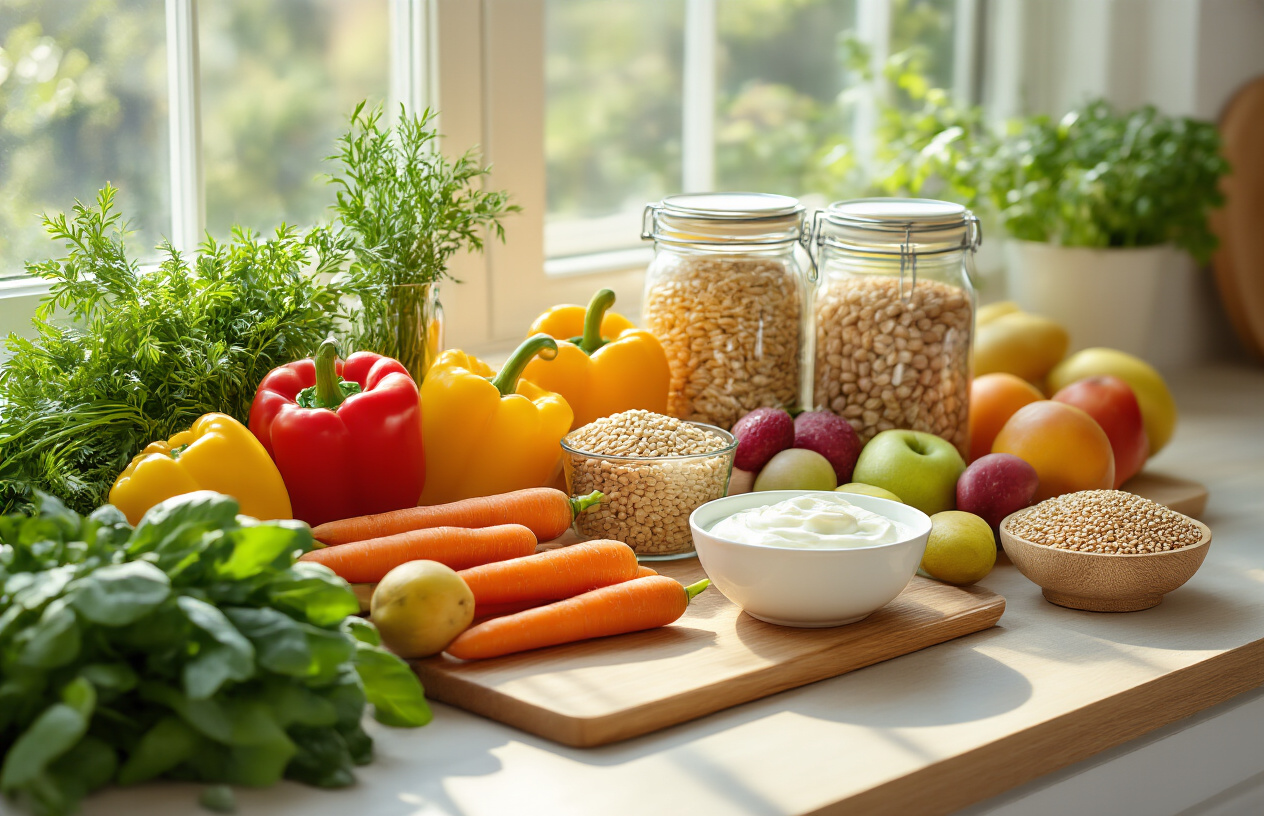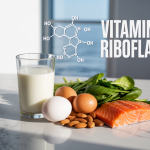Living with irritable bowel syndrome (IBS) can feel like a daily guessing game with your digestive system. Nutritional approaches to relieve IBS symptoms offer real hope for the millions of people dealing with unpredictable stomach pain, bloating, and bowel changes.
This guide is for anyone struggling with IBS who wants practical, science-backed dietary strategies that actually work. You don’t need to be a nutrition expert – just someone ready to take control of your gut health through smart food choices.
We’ll walk through how to identify your personal food triggers that set off symptoms, since what bothers one person might be perfectly fine for another. You’ll also learn about the low FODMAP diet, a proven approach that helps many people find relief by temporarily removing certain carbohydrates that can trigger IBS flare-ups. Finally, we’ll cover how to use probiotics and meal timing strategies to support your digestive system for long-term comfort.
Understanding IBS Triggers Through Food Identification

Recognize Common Food Triggers That Worsen Symptoms
Certain foods act like red flags for your digestive system when you have IBS. High-fat foods often top the list because they slow down digestion and can trigger painful contractions. Think greasy burgers, fried chicken, or heavy cream sauces – your gut might rebel against these rich options.
Spicy foods containing capsaicin can irritate your intestinal lining, leading to cramping and diarrhea. That extra-hot salsa or fiery curry might taste amazing going down, but your stomach could pay the price later.
Caffeine and alcohol deserve special attention too. Coffee, energy drinks, and alcoholic beverages stimulate your digestive tract and can speed up bowel movements or cause uncomfortable bloating. Even chocolate contains compounds that might trigger symptoms in sensitive people.
Gas-producing foods create their own set of problems. Beans, broccoli, cabbage, and carbonated drinks introduce extra air into your system, which can lead to painful gas and bloating. Raw vegetables, while healthy, can be harder to digest than their cooked counterparts.
Dairy products cause trouble for many IBS sufferers, especially those with lactose intolerance. Milk, cheese, and ice cream might trigger cramping, gas, and diarrhea. Artificial sweeteners like sorbitol, found in sugar-free gum and diet products, can have a laxative effect and worsen symptoms.
Track Symptoms Using Food Diaries for Pattern Recognition
A food diary becomes your detective tool for uncovering personal trigger patterns. Write down everything you eat and drink, along with portion sizes and timing. Don’t forget to record your symptoms – when they occur, how severe they feel, and how long they last.
Your diary should capture more than just food. Note your stress levels, sleep quality, menstrual cycle (if applicable), and any medications you take. These factors can influence IBS symptoms just as much as what you eat.
Use a simple rating system for symptoms – maybe 1 to 5, where 1 means mild discomfort and 5 represents severe pain. This helps you spot patterns more easily when you review your entries.
Digital apps can make tracking easier, but a simple notebook works just fine. The key is consistency – track everything for at least 2-4 weeks to gather enough data for meaningful patterns to emerge.
Look for connections between specific foods and symptom flare-ups. You might notice that symptoms appear 2-24 hours after eating certain foods, not immediately. This delayed reaction makes tracking so important for identifying your personal triggers.
Distinguish Between Food Intolerances and IBS Flare-ups
Food intolerances and IBS symptoms can look surprisingly similar, but they work differently in your body. Food intolerances happen when your digestive system lacks specific enzymes to break down certain foods. Lactose intolerance is a perfect example – your body doesn’t produce enough lactase enzyme to digest milk sugar properly.
IBS flare-ups, on the other hand, involve your gut’s hypersensitivity and abnormal muscle contractions. Your digestive system overreacts to normal stimuli, creating pain and irregular bowel movements even when you can technically digest the food.
Timing offers important clues. Food intolerance symptoms usually show up within a few hours of eating the problematic food and tend to be dose-dependent – more of the food means worse symptoms. IBS flare-ups can be more unpredictable, sometimes triggered by stress, hormones, or even weather changes.
The type of symptoms can help you tell them apart too. Food intolerances often cause gas, bloating, and diarrhea. IBS brings a wider range of symptoms including constipation, alternating bowel patterns, abdominal pain that improves after bowel movements, and mucus in stool.
Many people have both conditions, which makes things more complex. Working with a healthcare provider can help you sort out which symptoms come from what cause, leading to better treatment strategies.
Implement the Low FODMAP Diet for Symptom Relief

Learn Which High FODMAP Foods to Eliminate Initially
The elimination phase targets specific carbohydrate groups that commonly trigger IBS symptoms. High FODMAP foods contain fermentable oligosaccharides, disaccharides, monosaccharides, and polyols that can cause digestive distress.
Start by removing these major culprits from your diet:
Oligosaccharides (Fructans and GOS):
- Wheat, rye, barley, and onions
- Garlic, legumes, and cashews
- Artichokes and asparagus
Disaccharides (Lactose):
- Milk, yogurt, and soft cheeses
- Ice cream and cream-based sauces
Monosaccharides (Excess Fructose):
- Apples, pears, and mangoes
- Honey and high fructose corn syrup
- Dried fruits and fruit juices
Polyols (Sugar Alcohols):
- Stone fruits like peaches and plums
- Mushrooms and cauliflower
- Sugar-free gums and mints containing sorbitol or mannitol
Navigate the Three-Phase Approach for Maximum Benefits
The Low FODMAP diet works through a structured three-phase system designed to identify your personal triggers while maintaining symptom relief.
Phase 1: Elimination (2-6 weeks)
Remove all high FODMAP foods simultaneously. This strict phase allows your digestive system to calm down and symptoms to improve. Most people see significant relief within 2-3 weeks, but some may need up to 6 weeks for maximum benefit.
Phase 2: Reintroduction (6-10 weeks)
Systematically test one FODMAP group at a time while maintaining the low FODMAP base diet. This phase reveals which specific FODMAPs trigger your symptoms and at what quantities.
Phase 3: Personalization (Ongoing)
Create your individualized long-term eating plan based on your tolerance levels. You’ll include well-tolerated FODMAPs while avoiding or limiting your personal triggers.
Each phase serves a specific purpose, and rushing through them reduces the diet’s effectiveness. Patience during this process pays off with better symptom management and dietary freedom.
Reintroduce Foods Systematically to Identify Personal Triggers
The reintroduction phase requires careful planning and attention to detail. Test one FODMAP subgroup every 3-4 days to accurately identify your triggers.
Testing Protocol:
Start with a small portion on day one, increase to a moderate portion on day two, then a larger portion on day three. Monitor symptoms throughout this period and for 24 hours after the final test.
FODMAP Testing Order:
- Fructans: Begin with wheat or onion
- Lactose: Try milk or yogurt
- Fructose: Test honey or apple
- GOS: Use chickpeas or lentils
- Polyols: Start with sorbitol from stone fruits
- Mannitol: Test mushrooms or cauliflower
Keep detailed records of portion sizes, symptoms, and timing. Rate symptom severity on a scale of 1-10 to track patterns. If you react to a food, return to the elimination phase until symptoms subside before testing the next group.
Some people tolerate small amounts of certain FODMAPs but react to larger portions. Others may handle one food within a group but not another. This individual variation makes systematic testing essential for creating your personalized plan.
Maintain Nutritional Balance During FODMAP Restriction
Restricting FODMAPs can impact your nutritional intake, making strategic food choices essential for maintaining health during the elimination phase.
Ensure Adequate Fiber:
Replace high FODMAP fiber sources with suitable alternatives:
| High FODMAP Foods | Low FODMAP Alternatives |
|---|---|
| Wheat bread | Sourdough spelt, gluten-free options |
| Apples | Oranges, strawberries, kiwi |
| Onions | Green onion tops, chives |
| Legumes | Canned lentils (small portions) |
Maintain Prebiotic Intake:
Include low FODMAP prebiotic foods like unripe bananas, oats, and small portions of nuts and seeds. These support beneficial gut bacteria without triggering symptoms.
Address Potential Nutrient Gaps:
- Calcium: Choose lactose-free dairy or fortified plant milks
- B vitamins: Include quinoa, rice, and gluten-free fortified cereals
- Antioxidants: Focus on colorful low FODMAP fruits and vegetables
Work with a registered dietitian familiar with the Low FODMAP diet to ensure nutritional adequacy. They can help you plan balanced meals and identify suitable supplements if needed. Regular monitoring prevents nutritional deficiencies while you work toward identifying your personal triggers and creating a sustainable long-term eating plan.
Optimize Fiber Intake for Digestive Comfort

Choose Soluble Fiber Sources That Reduce Inflammation
Soluble fiber acts as your gut’s best friend when dealing with IBS symptoms. Unlike its insoluble counterpart, soluble fiber dissolves in water to form a gel-like substance that moves smoothly through your digestive tract, helping to calm irritation and reduce inflammation.
Oats stand out as an exceptional source, containing beta-glucan which specifically targets inflammatory responses in the intestinal lining. Start your day with a bowl of oatmeal topped with banana slices for a double dose of gut-soothing nutrition. Psyllium husk, available as a supplement or powder, provides concentrated soluble fiber that many IBS sufferers find remarkably effective for symptom management.
Apples without the skin offer pectin, a powerful soluble fiber that feeds beneficial gut bacteria while reducing intestinal inflammation. Carrots, sweet potatoes, and winter squash deliver similar benefits while adding variety to your meals. Barley and quinoa make excellent grain alternatives that provide steady amounts of soluble fiber without overwhelming your system.
Bean options require careful consideration – while black beans and lentils contain valuable soluble fiber, start with smaller portions to gauge your tolerance. Chia seeds mixed into smoothies or yogurt provide omega-3 fatty acids alongside soluble fiber for enhanced anti-inflammatory effects.
Gradually Increase Fiber to Prevent Symptom Aggravation
Your digestive system needs time to adjust to increased fiber intake, especially when managing IBS. Jumping into high-fiber foods too quickly can trigger bloating, gas, and abdominal discomfort – the exact symptoms you’re trying to avoid.
Begin with small portions and track your body’s response. Add just 2-3 grams of additional fiber every few days, allowing your gut bacteria to adapt gradually. This slow approach prevents the overwhelming fermentation that causes uncomfortable gas production and bloating.
Water intake becomes critical during this transition period. Aim for at least 8 glasses daily, as fiber requires adequate hydration to work effectively. Without sufficient water, fiber can actually worsen constipation and create harder stools.
Keep a food and symptom diary during this adjustment phase. Note which fiber sources your body tolerates well and which ones trigger symptoms. This personalized approach helps you build a sustainable fiber intake plan that supports digestive health without causing distress.
Consider starting with cooked vegetables rather than raw ones, as cooking breaks down some of the fiber structure, making it gentler on sensitive digestive systems. Steamed carrots, roasted butternut squash, and well-cooked spinach provide excellent starting points.
Balance Fiber Types for Optimal Bowel Function
Achieving the right balance between soluble and insoluble fiber creates the foundation for regular, comfortable bowel movements. While soluble fiber slows digestion and reduces inflammation, insoluble fiber adds bulk to stools and promotes movement through the intestines.
The ideal ratio for most IBS sufferers leans toward soluble fiber, roughly 75% soluble to 25% insoluble. This proportion helps maintain regularity without triggering the rapid transit that can worsen diarrhea-predominant IBS symptoms.
| Fiber Type | Best Sources | IBS Benefits |
|---|---|---|
| Soluble | Oats, bananas, carrots | Reduces inflammation, slows transit |
| Insoluble | Rice bran, potato skins | Adds stool bulk, prevents constipation |
| Mixed | Quinoa, sweet potatoes | Provides balanced digestive support |
Monitor your bowel patterns closely as you adjust fiber types. Constipation-predominant IBS may benefit from slightly more insoluble fiber, while those with diarrhea-predominant symptoms should emphasize soluble sources.
Timing matters too. Spread fiber intake throughout the day rather than consuming large amounts in single meals. This approach prevents overwhelming your digestive system and maintains steady, comfortable bowel function.
Consider fiber supplements when whole food sources aren’t sufficient, but choose products specifically designed for sensitive digestive systems. Methylcellulose-based options tend to be gentler than wheat-based supplements for IBS management.
Harness Probiotics and Prebiotics for Gut Health

Select Evidence-Based Probiotic Strains for IBS Management
Certain probiotic strains have shown promise in clinical studies for managing IBS symptoms. Bifidobacterium longum, Lactobacillus acidophilus, and Saccharomyces boulardii stand out as the most researched options for digestive relief. These specific strains help restore the natural balance of gut bacteria that’s often disrupted in people with IBS.
Bifidobacterium infantis 35624 has demonstrated particular effectiveness in reducing abdominal pain and bloating in multiple clinical trials. This strain works by producing anti-inflammatory compounds that calm intestinal irritation. Lactobacillus plantarum 299v shows strong results for reducing gas and improving overall digestive comfort.
Multi-strain probiotics often provide better results than single-strain supplements. Look for products containing at least 10-50 billion colony-forming units (CFUs) per dose. The quality matters more than the quantity, so choose reputable brands that guarantee live cultures through the expiration date.
Incorporate Prebiotic Foods That Support Beneficial Bacteria
Prebiotics serve as food for the beneficial bacteria already living in your gut. Unlike probiotics, which add new bacteria, prebiotics nourish existing colonies to help them thrive and multiply. This approach creates a more sustainable environment for gut health improvement.
Start with small amounts of prebiotic-rich foods to avoid digestive upset. Garlic, onions, and asparagus contain inulin, a powerful prebiotic fiber. However, these foods are high in FODMAPs, which might trigger symptoms in sensitive individuals. Green bananas, oats, and flaxseeds offer gentler alternatives that most people can tolerate well.
Jerusalem artichokes and chicory root provide high concentrations of prebiotic compounds but should be introduced gradually. Begin with a teaspoon of ground flaxseed or half a green banana daily, then slowly increase portions based on your body’s response.
| Prebiotic Food | Starting Amount | Prebiotic Type | IBS-Friendly Rating |
|---|---|---|---|
| Green bananas | 1/2 banana | Resistant starch | High |
| Oats | 1/4 cup | Beta-glucan | High |
| Flaxseeds | 1 tsp | Mucilage | High |
| Garlic | 1 small clove | Inulin | Low (high FODMAP) |
| Asparagus | 5 spears | Inulin | Low (high FODMAP) |
Time Probiotic Supplementation for Maximum Effectiveness
Taking probiotics at the right time maximizes their survival through your digestive system. Most probiotic bacteria are sensitive to stomach acid, which peaks during and immediately after meals. Taking supplements 30 minutes before eating or 2-3 hours after meals gives the beneficial bacteria the best chance to reach your intestines alive.
Some probiotic strains actually perform better when taken with food. Saccharomyces boulardii, a beneficial yeast rather than bacteria, can be taken at any time since it’s naturally resistant to stomach acid. Check your supplement label for specific timing recommendations from the manufacturer.
Consistency matters more than perfect timing. Choose a schedule you can stick with daily, whether that’s first thing in the morning or before bed. Your gut bacteria thrive on routine, and regular supplementation helps maintain stable populations of beneficial microorganisms.
Split higher doses throughout the day rather than taking everything at once. If your supplement contains 50 billion CFUs, consider taking half in the morning and half in the evening for better colonization.
Monitor Gut Response to Avoid Unwanted Side Effects
Starting probiotics can temporarily increase gas, bloating, or changes in bowel movements as your gut bacteria adjust to the new additions. These symptoms typically resolve within 1-2 weeks as your microbiome reaches a new balance. Keep a simple symptom diary to track your body’s response and identify any concerning patterns.
Begin with lower doses than recommended and gradually increase over 2-3 weeks. If you experience persistent bloating or worsening symptoms after two weeks, the strain might not be right for your particular gut environment. Some people respond better to different bacterial species.
Watch for signs that indicate you should pause or discontinue use: severe abdominal cramping, persistent diarrhea lasting more than three days, or any symptoms that feel markedly worse than your baseline IBS symptoms. People with compromised immune systems or serious underlying health conditions should consult healthcare providers before starting probiotic supplements.
Temperature-sensitive probiotics lose potency when exposed to heat, so store supplements properly in cool, dry places or refrigerate as directed. Expired probiotics won’t harm you but provide little benefit since the bacterial counts drop significantly over time.
Strategic Meal Planning and Eating Habits

Structure Meal Timing to Reduce Digestive Stress
Regular meal timing acts as a natural rhythm setter for your digestive system. When you eat at consistent intervals, your body learns to prepare digestive enzymes and gastric acids at predictable times, reducing the likelihood of IBS flare-ups. Aim to eat every 3-4 hours throughout the day, starting with a substantial breakfast within an hour of waking up.
Avoid long gaps between meals, as this can lead to overeating and digestive overwhelm when you finally sit down to eat. Late-night eating disrupts your body’s natural circadian rhythm and can trigger morning symptoms. Try to finish your last meal at least 3 hours before bedtime to give your digestive system time to process food properly.
Consider implementing a “breakfast first” approach – never skip this meal as it kickstarts your metabolism and sets the tone for stable blood sugar throughout the day. If morning appetite is poor, start with something small like a banana with almond butter or a smoothie made with low-FODMAP ingredients.
Control Portion Sizes to Prevent Symptom Triggers
Large meals overwhelm your digestive system and often trigger IBS symptoms like bloating, cramping, and urgency. Smaller, more frequent meals distribute the digestive workload evenly throughout the day, making it easier for your gut to process food without distress.
Use the “plate method” as your portion guide: fill half your plate with low-FODMAP vegetables, one quarter with lean protein, and one quarter with safe carbohydrates. This visual approach helps maintain proper proportions without requiring precise measurements.
Portion Control Strategies:
- Use smaller plates (8-9 inches) to naturally reduce serving sizes
- Eat slowly and pause halfway through your meal to assess hunger
- Stop eating when you feel 80% full
- Pack away leftovers immediately to avoid mindless overeating
- Measure trigger foods like nuts, dried fruits, or dairy alternatives
Pay special attention to portion sizes of high-FODMAP foods you’re testing during reintroduction phases. Even “safe” foods can become problematic when consumed in large quantities.
Practice Mindful Eating Techniques for Better Digestion
Your mental state directly impacts digestion through the gut-brain connection. Stress, anxiety, and rushing through meals can trigger IBS symptoms even when eating safe foods. Mindful eating practices help activate your parasympathetic nervous system, which optimizes digestive function.
Create a calm eating environment by turning off screens, sitting at a table, and taking three deep breaths before your first bite. Chew each bite thoroughly – aim for 20-30 chews per mouthful. This mechanical breakdown reduces the workload on your stomach and improves nutrient absorption.
Mindful Eating Checklist:
- Eat without distractions (no phone, TV, or computer)
- Focus on food textures, flavors, and aromas
- Put your fork down between bites
- Check in with hunger and fullness cues
- Practice gratitude for your meal
If you notice tension in your shoulders or jaw while eating, pause and take several deep breaths. Stress eating often leads to poor food choices and digestive discomfort.
Prepare IBS-Friendly Meals That Satisfy Nutritional Needs
Meal prep becomes your best friend when managing IBS, as it ensures you always have safe options available and reduces decision fatigue during busy weeks. Focus on simple, nutrient-dense combinations that provide sustained energy without triggering symptoms.
Build your meal prep around versatile base ingredients like quinoa, rice, chicken, fish, and low-FODMAP vegetables. Cook large batches of these staples and mix-and-match throughout the week with different seasonings and safe condiments.
Weekly Prep Essentials:
- Cooked grains (quinoa, rice, gluten-free oats)
- Roasted vegetables (carrots, zucchini, bell peppers)
- Portioned proteins (grilled chicken, baked salmon, tofu)
- Safe snacks (rice cakes, small portions of nuts, bananas)
- Homemade salad dressings with olive oil and herbs
Keep emergency meals in your freezer – simple combinations like rice with chicken and steamed vegetables that can be quickly reheated. Always have backup options for days when cooking feels overwhelming or symptoms are particularly challenging.
Manage Eating During Social Situations and Travel
Social eating doesn’t have to derail your IBS management plan with proper preparation and communication strategies. Research restaurant menus in advance and identify safe options, or call ahead to discuss ingredient modifications with kitchen staff.
When dining out, stick to simple preparations like grilled proteins with steamed vegetables and plain rice or potatoes. Request sauces and dressings on the side, and don’t hesitate to ask about cooking methods or hidden ingredients that might contain garlic, onions, or other triggers.
Travel-Ready IBS Kit:
- Portable snacks (rice crackers, bananas, safe energy bars)
- Travel-size bottles of safe seasonings and condiments
- Digestive enzymes or approved medications
- Emergency meal replacement shakes
- Restaurant cards explaining your dietary needs
For longer trips, research grocery stores near your destination and plan to stock up on safe foods upon arrival. Pack extra snacks in case of flight delays or limited food options. Many airports now offer healthier options, but having backup foods ensures you won’t be caught without safe choices.
Consider staying in accommodations with kitchen access when possible, allowing you to maintain better control over your meals while away from home. This reduces stress and helps maintain your routine even in new environments.

Managing IBS doesn’t have to feel overwhelming when you know which foods work for your body and which ones don’t. The combination of identifying trigger foods, following a low FODMAP approach, balancing your fiber intake, and incorporating gut-friendly probiotics can make a real difference in how you feel day to day. Add some smart meal planning and mindful eating habits to the mix, and you’ve got a solid foundation for better digestive health.
Your gut is unique, so what works for someone else might not work for you. Start with one approach at a time, keep track of how different foods affect you, and be patient with the process. Small, consistent changes often lead to the biggest improvements in managing IBS symptoms and getting back to enjoying your meals without worry.













